I’ve collected many things over the years: baseball cards, trains, decoys, cookie jars, and much more. In the 1980s, I went through a stoneware phase. Stoneware was the tupperware of the late 18th century and most of the 19th century: an all purpose storage container. It could hold liquids and solids. American stoneware is a fascinating product–each piece created and decorated individually.
Pottery-making is one of America’s most ancient crafts. For many potters, making stoneware from clay, then firing it in a kiln, was a business that required little start-up capital, but often resulted in a business that quickly died. However, for those rare successes, the pottery-making business often was passed from generation to generation. And there were few, if any, stoneware families more prominent than the Crolius family. In 1730, William Crolius, a German immigrant from the Rhineland, which itself had a rich tradition of pottery-making, established his stoneware business on Pot Baker’s Hill in Manhattan. You might have guessed: the Crolius family of potters are interred at Green-Wood Cemetery.
Pot Baker’s Hill was a marshy and undeveloped area in Manhattan, just north of today’s City Hall, and just east of Broadway. It was on the outskirts of the 18th-century city.
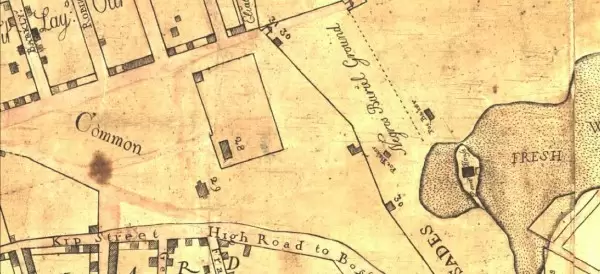
In fact, some of the earliest lots at Green-Wood–lots 46 and 59–were sold to Crolius family members. Crolius was an unusual 19th century name in America: checking the American Civil War Research Database, which lists 4.2 million men who served in the Civil War from 1861 to 1865, 4 entries are for men named Crolius who served in the Union Army; the Confederate forces had no man named Crolius. But Green-Wood lists 68 people named Crolius in our interment database. In all, there were 15 Crolius potters, including 6 named William, five Johns, one George, and two Clarksons. Green-Wood has 6 Williams, 4 Johns, 7 Georges, and three Clarksons–the bulk of the Crolius potters.
The first Clarkson Crolius (1774-1843) was the grandson of William Crolius, the founder of the family business, and the son of John and Maria Clarkson Crolius. He was involved in politics, serving as an alderman in New York City’s Sixth Ward for many years, as an assemblyman, and in 1825 was elected Speaker of the New York State Assembly. By 1811, he had risen to be Grand Sachem of the Tammny Society; he laid the cornerstone for the Old Tammany Hall that was built on Frankfort Street. He was also active in the military; during the War of 1812, Clarkson served as major of the 29th New York State Militia, then entered U.S. service, and rose to colonel. This mix of politics and military service was no accident. There was a spike in new American potteries around 1805; these were early American manufacturers, started in an effort to establish economic independence from England. Federal legislation from 1806 to 1809, and the Embargo Act of 1807, prohibited trade with England, and English imports fell by two-thirds; American manufacturers, including potters, had little competition from imports, and thrived.
Clarkson was in the stoneware business by 1794; he later moved the family pottery business to Bayard Street, but continued to live on Reade Street, near where the pottery had been.
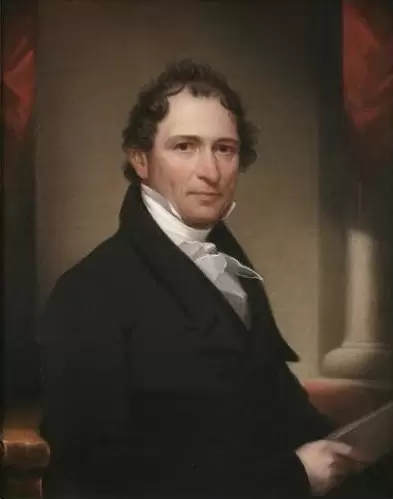
The Crolius Pottery produced stoneware, typically light gray or tan, that was salt-glazed and often decorated with die-stamped and/or incised patterns colored with a cobalt blue glaze.
I have just purchased the Crolius piece below on behalf of The Green-Wood Historic Fund. It is in rough shape–shattered into pieces, it has been crudely glued back together. It also has a substantial chip along its rim, and the surface is rough at the outside bottom, likely from the extended storage of a liquid. But it is a rare piece: according to Donald Blake Webster, in his landmark “Decorated Stoneware Pottery of North America,” published in 1971, “marked pieces by Clarkson Crolius of New York City are among the rarest examples of stoneware . . . .” And, this piece’s design is really quite exceptional. First of all, not all of Crolius’s pieces were marked. Note the maker’s mark pressed into the front and highlighted with a cobalt blue slip:
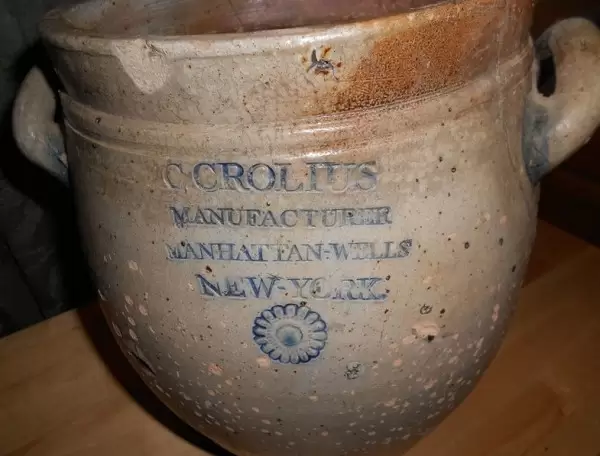
And note the very nice die-stamped design below the maker’s mark–what looks like the center of a flower pressed into the soft clay before firing in a kiln.
Now take a look at the back of this crock:
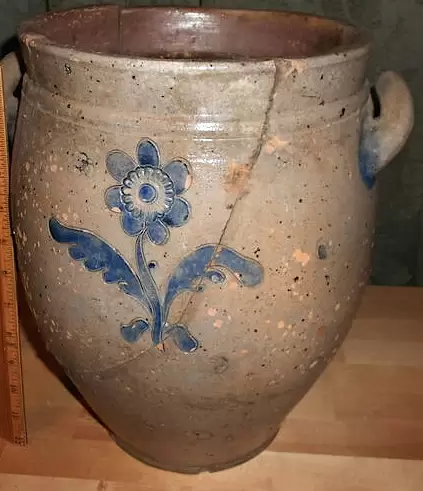
Note that the same decorative stamp that was used on the front, below the makers mark, has also been used here, to create the pistil of the flower, with flower petals then incised around it. And here is the same stamp in use again on another piece of stoneware:
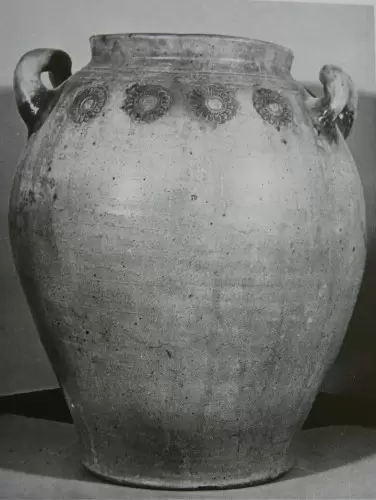
Clarkson Crolius’s son, the second Clarkson Crolius (1801-1887), went into business with his namesake, and continued the family’s pottery business until his retirement in 1870. The New-York Historical Society owns Clarkson Crolius, Jr.’s maker’s stamp and many of his tools. He also is interred at Green-Wood.
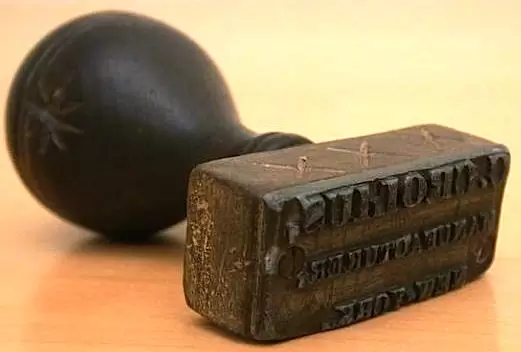
Very nice little article about the Crolius family of potters. I was wondering if you could confirm the material from which Clarkson Crolius’ name stamp is made. Is it a cast brass plate that is screwed to the turned wood handle?
Thanks!
Thanks!
That would be my guess from looking at the photograph–wood with a brass plate stamp. It is at the New-York Historical Society; I visit it whenever I am there, up in the Luce Center. If you call there, they should be able to confirm the materials.
I descended from the youngest John in civil war. I believe he married Jane Morgan. Am interested in learning family history. Visited Brooklyn just this summer for Prospect park wedding, but unfortunately did not know of green-wood. Will visit next time. We did visit the African burial grounds. Other than Internet searching, do you have suggestions about how to learn more while visiting NYC area?
Green-Wood can help you with your family history through its Green-ealogy services–histories of your ancestors, much of which is available nowhere else. To find out more, go here: http://www.green-wood.com/2012/green-ealogy-genealogical-research-at-green-wood/
Thanks very much. I will follow up on your suggestion. Sorry, I meant Revolutionary War above, not Civil.
Jim,
Clarkson Crolius, Sr pictures above is my 5x Great-Grandfather. Would love to connect and collaborate on our shared history!
Jane Morgan was likely from the Morgans of Cheesequake, NJ also a very important family in the stoneware community. For a long time most of the best stoneware clays were mined from the Morgan bank on Raritan Bay
Great read on the history of Crolius. Really enjoyed it, BRAVO!!
Thanks!
My mothers maiden name was Crolius and her father was Clarkson ,mother Mary ,sisters Jennie ,Mary and Kate,brothers George ,Vincent to the best of my knowledge he was born in 1854.I attended his funeral in 1947
Hi. I love this piece and am actually related to the Crolius family. My great great grandmother is Lydia Crolius, daughter of Clarkson Crolius Sr. We’re just tracing our family tree and love what we’re finding.
Great! Happy to be of help!!!
I live near Fredericksburg, Virginia, in south Stafford County. In the winter of 1862-63 Union troops were camped all around our property, including from some New York units. I dug-up a NY National Guard uniform button just outside our back door, ironic since my fresh of the boat from Germany great-great grandfather joined the NY Guard a few years after the War. Anyway, while preparing a plot for potatoes I uncovered a large piece of stoneware with most of the C.Crolius logo intact (wish I could attach a photo). Many other shards have presented themselves, probably about one-fourth or so of a complete crock. Pity the lads were not more careful with it and buried it whole. But thank you for your history, gives life to these pieces of the past.
That’s a wonderful story. Thanks for sharing!
For more information about the Crolius family and their pots see https://chipstone.org/article.php/412/Ceramics-in-America-2008/New-York-City-Stonewares-from-the-African-Burial-Ground and various catalogs and videos from Crocker Farm https://www.crockerfarm.com/ especially https://www.crockerfarm.com/highlights/new-york-stoneware/
I am Jacquie Crolius. I married Marcus Crolius.
My husband’s dad was Robert William Crolius. Does anyone know if the Crolius family had a family crest?
Thanks!
Jacquie
My great-grandmother was a woman named Jesse, and Crolius was her maiden name before she got married. Very cool write-up on the family! I do stoneware pottery with a lot of floral motifs myself, so it’s fun to see that my ancestors had similar aesthetic sensibilities.
I do find such discoveries fascinating–that you, presented with a range of choices of how to occupy your time, chose the same thing as your ancestors!
My maternal Great Great Grandfather was Thomas M. Mulry. He was married to Parthenia Crolius.
I think Clarkson was her father.
My maternal Great Grandfather was:
https://en.wikipedia.org/wiki/Thomas_Maurice_Mulry
He was President of the Emigrant Bank in 1920.
Mulry Square in NYC was named after him.